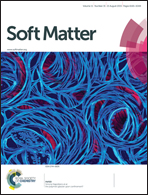FRET evidence for untwisting of amyloid fibrils on the surface of model membranes
Abstract
Apolipoprotein A-I (apoA-I) is an amyloid-forming protein whose amyloidogenic properties are attributed mainly to its N-terminal fragment. Cell membranes are thought to be the primary target for the toxic amyloid aggregates. In the present study Förster resonance energy transfer (FRET) between the membrane fluorescent probe Laurdan as a donor and amyloid-specific dye Thioflavin T (ThT) as an acceptor was employed to explore the interactions of amyloid fibrils from apoA-I variants 1–83/G26R and 1–83/G26R/W@8 with the model membranes composed of phosphatidylcholine and its mixture with cholesterol. The changes in FRET efficiency upon fibril–lipid binding were found to correlate with the extent of protein fibrillization. AFM imaging revealed the presence of two polymorphic states of fibrillar 1–83/G26R/W@8 with the helical and twisted ribbon morphologies. The simulation-based analysis of the experimental FRET profiles provided the arguments in favor of untwisting of fibrillar assemblies upon their interaction with the model membranes. Evidence for the face-on orientation and superficial bilayer location of the membrane-bound fragments of 1–83/G26R/W@8 fibrils was obtained.


 Please wait while we load your content...
Please wait while we load your content...